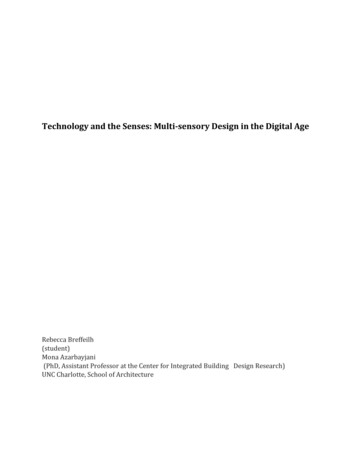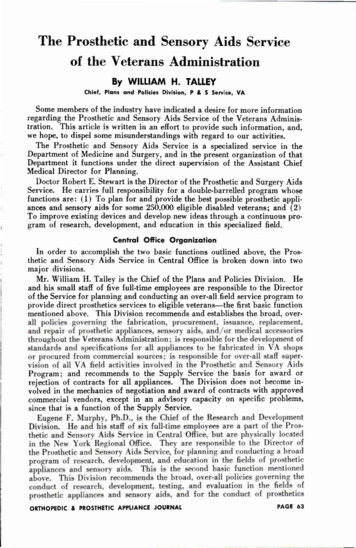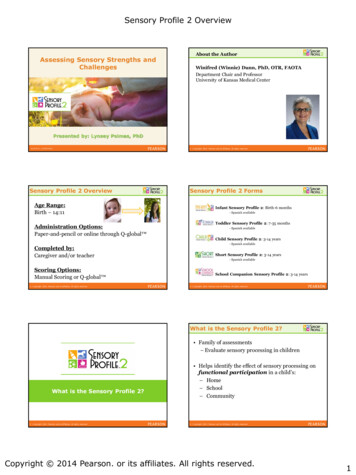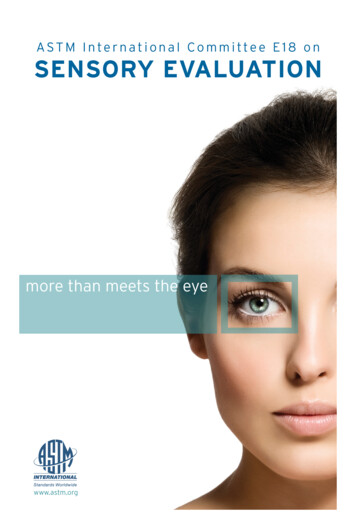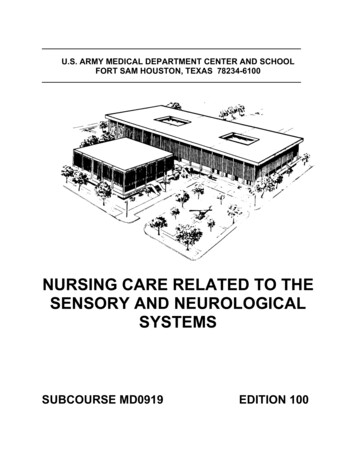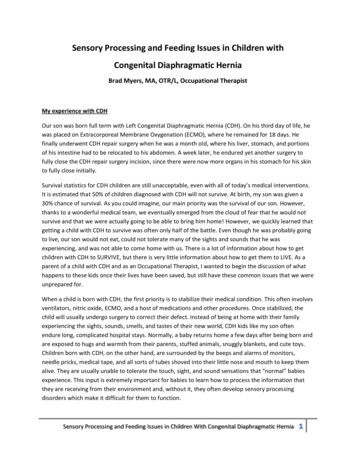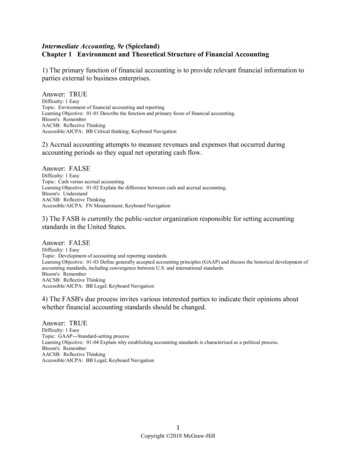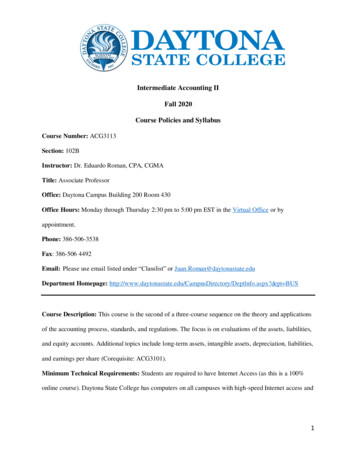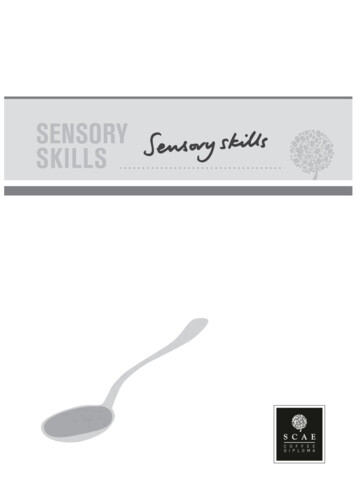
Transcription
SENSORY INTERMEDIATEBLOOMS TAXONOMY: Remembering / UnderstandingLevel 3: Application – Use information in a new duleOutRepairPracticeDramatiseUseSolveExplainLevel 4: Analysis – Distinguish the different reRecogniseDetermine2
SUBCODEKNOWLEDGE/SKILL REQUIREDSTANDARDSREFERENCEL3, L4Stone, H and Sidel, JL (2004)Sensory Evaluation practices,rd3 EditionAcademic, San Diego1.0 HOW WE TASTE, PERCEIVE AND INTERPRET - GENERALITIES1.01.01WHAT IS SENSORY ANALYSISSensory evaluation has been defined as a scientific methodused to evoke, measure, analyse and interpret thoseresponses to products as perceived through the senses ofsight, smell, touch, taste and hearing (Stone and Sidel, 2004)Lawless, HT and Heymann , H completed this definition bydistinguishing four phases to sensory evaluation:- “Evoke”: understand the products and define theirpresentation conditions to control potential bias- “Measure”: sensory is a quantitative science in whichdata are collected establish relationships between productcharacteristics and human perception (sensory or moreelaborated such as liking, etc.)- “Analyse”: Proper statistical analysis is a critical part ofsensory testing. Statistical methods are used to determineif the relationships between product characteristics are likelyto be real and not due to uncontrolled variations- “Interpret”: It is important to consider the method used,its limitations to make a decision within the context of the studyLawless, HT, Heymann, H(2010)Sensory Evaluation of FoodPrinciples and Practicesnd2 EditionSpringer, New YorkMeilgaard, M & co (1999)Sensory evaluation techniques3rd EditionCRC Press LLC, Boca Raton,FLCarpenter, RP & co (2000)Guidelines for Sensory Analysisin Food Product Developmentand Quality Controlnd2 EditionAspen Publishers, Gaithersburg,MDCastriota-Scanderbeg, A et al“The appreciation of wine bysommeliers: a functionalmagnetic resonance study ofsensory integration”3
SUBCODEKNOWLEDGE/SKILL REQUIREDSTANDARDSREFERENCE1.01.02Explain the challenge of working with a human measuringinstrument that is highly variable across the population andover timeL3, L4Stone, H and Sidel, JL (2004)Sensory Evaluation practices,rd3 EditionAcademic, San DiegoWorking in sensory science requires that you can demonstrateknowledge in the following disciplines: sensory physiology,psychology, experimental design and statisticsLawless, HT, Heymann, H(2010)Sensory Evaluation of FoodPrinciples and Practicesnd2 EditionSpringer, New YorkDifferentiate between the objective judgment of the trainedtaster from the subjective judgment of the consumersExplain a panel set up typically requires: Trained tasters 6 to 40 making a panel Standard questions/questionnaires Preparation protocol Test design Analysis FacilitiesMeilgaard, M & co (1999)Sensory evaluation techniques3rd EditionCRC Press LLC, Boca Raton,FLCarpenter, RP & co (2000)Guidelines for Sensory Analysisin Food Product Developmentand Quality Controlnd2 EditionAspen Publishers, Gaithersburg,MDExplain the panel aims to: Identify Discriminate Describes Compares Investigate Hedonic Judgment (preference, liking)1.02.01WHY IS SENSORY IMPORTANT IN COFFEESensory Evaluation role:- Identify which sensory profiles are preferred by end users- Relate sensory profiles and other product characteristics:physical, chemical, recipe, process- Scope: quality control, product development, marketinginnovation, consumer acceptance and communicationTechnique widely used in food industry extended to others(car, perfumery, tobacco, pharmacy, etc ),. for QualityControl, or Product DevelopmentCastriota-Scanderbeg, A et al“The appreciation of wine bysommeliers: a functionalmagnetic resonance study ofsensory integration”L3, L4Lingle (2001)Muñoz, AM, Civille, GV andCarr, BT (1992)Sensory Evaluation In QualityControlVan Nostrand Reinhold,New York.Yantis, JE [Ed] (1992)The Role of Sensory Analysis inQuality ControlASTM. West Conshohocken, PA4
SUBCODEKNOWLEDGE/SKILL REQUIREDSTANDARDSREFERENCE1.02.02Recall that cupping seeks to: Identify potential defects and taints Identify positive flavours and their quality Evaluate intensity Record the resultsL3, L4Lingle (2001)Muñoz, AM, Civille, GV andCarr, BT (1992)Sensory Evaluation In QualityControlVan Nostrand Reinhold,New York.Explain that sensory analysis establishes a general picture ofa coffee’s potential that can be refined and adjusted to variousgreen coffee selection, blending and brewing practicesYantis, JE [Ed] (1992)The Role of Sensory Analysis inQuality ControlASTM. West Conshohocken, PA2.0 PHYSIOLOGY AND SENSORY ATTRIBUTES2.01.01PHYSIOLOGY (be general)The Senses: Mouth (taste buds) Nose (olfactory bulb)Examples: Sugar Cinnamon2.02.01PSYCHOLOGICAL (be general)The human as the measurement instrumentIts limits: biasExample:Wine – Grand Cru vs mainstream: Which one is betterExample:Hawaii Kona and Brazil NY2 FC: Which is more aromatic2.03.01TASTE AND TEXTURES IN THE CONTEXT OF COFFEEMAIN FOCUS OF THE COURSEThere are 5 prototypical tastesL3, L4All coffees are naturally acid, bitter and have a sweetperception (more than they are physically sweet)Show: 2.03.02AstringencyBodyPungentSweet perceptionBe able to recognise different tastesL3, L4Ability to discriminate between, and rank, four levels of acidityand bitterness in solution2.04.01DEFINE POSITIVE AND NEGATIVE AROMAS IN COFFEE(below Aroma and Flavour)Recognise and categorise key positive aromas in coffeeL3, L45
SUBCODEKNOWLEDGE/SKILL REQUIREDSTANDARDS2.04.02Smell positive aromasL3, L42.05.01AROMAS AND FLAVOURS IN THE CONTEXT OF COFFEEGreen coffee contains aroma precursors. Roasting consists ina variety of chemical reactions aiming to create aromas.Brewing does not produce any new volatiles, but merelyextracts a percentage of what is in a roasted beanREFERENCEL3, L4Model SCAA/SCAEi) fruity, flowery, herbalii) nutty, caramel, chocolatyiii) turpeny, spicy, carbon-like2.05.02Describe blind aroma of cola syrup or grenadine syrup;realise the diversification of descriptorsL3, L4Accurately categorise and identify key aromas present incoffee3.0 TRIANGLE TEST3.01.01SCOPE OF APPLICATIONIs there a difference, are products similar?3.02.01DEFINITION AND DESCRIPTIONOut of the three, which is the odd sample?L3, L4See What is sensory evaluationL3, L4See What is sensory evaluationDefinition, questionnaire, experimental design (6 permutations)Three digit codesNumber of assessors (18 for difference, 36 for similarity)3.02.02Conduct a triangle test on two coffees, eventually repeattriangle to reach 24 to 30 answers3.03.01STATISTICAL ANALYSISPrinciple of the statistic testTable, risk α and βTest for difference, similarity3.04.01ALTERNATIVE METHODSMention duo – trio; pair test4.0 RUNNING A CUPPING SESSION AND TASTING THE DIVERSITY OF COFFEE – CUPPING GENERALITIES4.01.01WHAT IS CUPPINGIt is a sensory analysis process specific to coffee“Coffee cupping is a method used to systematically evaluatethe aroma and taste characteristics of a sample of coffeebeans” – (Ted Lingle 2001)L3, L4SCAALingle‘Coffee Cuppers Handbook’6
SUBCODEKNOWLEDGE/SKILL REQUIREDSTANDARDSREFERENCE4.01.02Repeat a definition of cuppingL3, L4SCAALingle‘Coffee Cuppers Handbook’4.02.01KEY TERMINOLOGY/SENSORY VOCABULARYCupping coffee with:L3, L4Coffee – Sensorial Analysis –VocabularyISO TC 34/SC 15N 2113L3, L4Coffee – Sensorial Analysis –VocabularyISO TC 34/SC 15N 2113Eye: colour, froth, cremaNose: aroma categories (see point 5)Mouth: basic tastes and mouthfeel4.02.02Match key cupping terminology phrases with an explanation ofthe terms4.03.01SENSORY QUALITIES IN COFFEE: TASTES AND BODYIn coffee basic tastes and aromas do not exist in isolation andthey need to be recognised within the brewed coffee itselfL3, L4The body of the coffee describes the apparent viscosity,fullness and weight in the mouth ranging from "thin, watery"to "thick, heavy"4.03.02Acknowledge that acidity, bitterness and body are origin andprocess dependentL3, L4Triangle tests5.0 CUPPING SYSTEMS IN USE5.01.01DIFFERENT CUPPING SYSTEMThe SCAA cupping form, a standardL3, L4Espresso Cupping System or brewing (filter, French press)objective is to adapt to the end product5.01.02Explain there are a number of scoring cupping forms in useL3, L4Distinguish between these forms and highlight differences intable set up for each formIdentify differences in specific attributes of a cupping form inthree different coffees5.02.01CORE CUPPING PROTOCOL; THE MEANING OF THESTANDARD PREPARATION VALUESMention, explain generally5.03.01COMMUNICATING THE RESULTSMention, explain generally7
SUBCODEKNOWLEDGE/SKILL REQUIREDSTANDARDSREFERENCE6.0 HOW TO SET UP SENSORY IN YOUR BUSINESS AND SENSORY APPLICATIONS – EQUIPMENT, MAINTENANCE AND STAFF6.01.016.01.02WHAT IS PANEL AND WHY SET UP A PANEL? (Ref 1.0)- A group to a one person- Is a measurement instrumentL3, L4A group is better, more objective, not personalL3, L4One is better than none6.02.01FACILITATING, TASTING AND PREPARATION AREABasics, mention standard6.03.01GOOD PRACTICES, EQUIPMENT AROUND TASTING ANDSAMPLES, CLEANING, STORAGE (Show lab pictures) Booth Table Spittoon Cups Spoons Water quality (treatment) Temperature6.03.02Explain that equipment can vary in modality(Example: turning table or not, sink spittoon or not).L3, L4L3, L4Identify the repeatability of testing and brew protocol as beingthe important point7.0 SET UP YOUR SENSORY PANEL7.01.01WHAT PANEL FOR WHAT TESTDiscriminative vs descriptive testQuantitative vs qualitativeRobust vs informal7.01.02Adapt your tests to your needs (objective, time, budget)in order to set up the right panel7.02.01SCREENING TASTERSIt is important that the panelists should have at least normalsensory sensitivity to any tests being carried outL3, L4L3, L4L3, L4Meilgaard et al 2007 (Chapter 9)Avoid blind tasters in your panelGive awareness to potential tasters on sensory fundamentalsand requirementsThis makes best use of time and investment, selectingaccurate and motivated people8
SUBCODEKNOWLEDGE/SKILL REQUIREDSTANDARDSREFERENCE7.02.02Distinguish between tasters and non-tastersL3, L4Meilgaard et al 2007 (Chapter 9)L3, L4Standard ISOExplain that people taste different, tasting relies on acuity noton hierarchy in companyExplain that a ranking test is an effective way of screeningpossible panel members7.03.01TRAIN YOUR PANEL AND PANELLISTSLong process: 6 months minimumProgram example in content and timeSCAA, COE trainingRatio: nb tasters / taster expertise / scopeDepend on activityBe practical and adapted to thetopic in content and time:DefectGreen coffeeRoastingBrewingFrom the In/Out panellist to the SCAA/COE jury7.03.02Recognise that developing an appropriate level of sensitivity incoffee and gaining knowledge takes timeL3, L4Standard ISOSCAA, COE trainingImproving calibration, recognition and broadening the range ofsensory test protocols a cupper has knowledge of, is part oftheir learning journey7.04.01Depend on activityBe practical and adapted to thetopic in content and time:DefectGreen coffeeRoastingBrewingCHECK PERFORMANCE AND CALIBRATIONImportance, mention, must have8.0 APPLICATION – ADVANTAGE AND LIMIT OF IN/OUT VS DESCRIPTIVE FOR QC, NPD – RELATION WITH ANALYTICAL8.01.011. THE IN/OUT METHOD (Illustrate practically)A simple methodL3, L4Good for routineRequire standard and calibration on simple sensorydimensionsBased on Reference sampleIdeal for on-going production positive releaseAn alternative test is the duo-trio9
SUBCODEKNOWLEDGE/SKILL REQUIREDSTANDARDS8.01.02Describe the protocol of in/outL3, L4REFERENCERecognise this is a core methodology used in coffee roasteryquality assurance, especially where there are small numbersof trained tastersPass an in/out practical test8.02.012. TRIANGLE TEST(See before)For QC, NPD ex: Change of roasting profile, change ofsupplier, change of water, 8.02.02Ease of applicationNo training requiredPreparation methodNeed for number of tasters8.03.013. GREEN COFFEE QUALITY CONTROL(Mention that SCAA cupping can be this)Can be based on simplified SCAA analysis or simply anIn/Out testL3, L4Determining standards in green coffee is a primary qualitymarker for all subsequent quality checksVariables include defects, colour, smell, roast appearanceCan be done for benchmark competition tasting (to be tackledin Professional)8.03.02Explain that recording green coffee samples and their qualityis the base point for all roastery quality managementL3, L410
Key TerminologyWord orTermProposed DescriptionSourceAcidityA basic taste characterised by the solution of an organic acid. A desirablesharp and pleasing taste as opposed to an over-fermented sour tasteICO, 1991AftertasteThe sensation produced by the lingering taste and aromaCappuccio, 2005AromaThe sensation of the gases released from brewed coffee, as they are inhaledthrough the nose through sniffingLingle, 2011AstringentAn aftertaste sensation consistent with a dry feeling in the mouth,undesirable in coffeeICO, 1991BalanceA pleasing combination of two or more primary taste sensationsLingle, 2011Basic TastesThe five basic tastes of sweet, sour, bitter, salty and umamiBodyThe physical properties of the beverage. A strong, but pleasant, fullmouthfeel characteristicBreakAromatic assessment of the crust as it is broken three timesCleanFree from flavour taints or faultsCrustAromatic assessment of the crust of wet coffee grounds that forms on the topof the brew surface immediately after brewingCuppingA method used to systematically evaluate the aroma and tastecharacteristics of a sample of coffee beansLingle, 2011CuppingGlasses/BowlsAll cups or glasses used should be of the same volume, dimensions andmaterial of manufacture:SCAA, 2009ICO, 1991Lingle, 2011Cupping Glasses5 to 6 oz tempered glassPorcelain bouillon bowls of175-225ml clean cups should be clean with no apparent fragrance and atroom temperatureCupping GrindCoarser than filter grind with 70% to 75% passing through a 850mμ sieveSCAA, 2009Cupping RoastSample roast targets: Time: 8 – 12 minutes depending on roaster size Colour: Agtron 60 – 65 (M-Basic)/Probat 105– 125 (colourette) Coffees cupped 8 - 24 hours after roastingSCAA, 2009DryAssessment of the fragrance of the dry coffee grounds after grinding andprior to brewingFlavourThe sensation in mouth the coffee gives by the combination of Tastes andAromas in the liquid phase11
FragranceThe sensation of the gases released from roasted and ground coffee beans,as the aromatic compounds are inhaled through the nose by sniffingLingle, 2011Gustation“The detection of stimuli dissolved in water, oil, or saliva, by the taste buds”Meilgaard et al, 2007MouthfeelThe tactile sense derived from physical sensations in the mouth during andafter ingestionLingle, 2011OlfactionThe sense of smell allowing the perception of aroma, fragrance, scents ingas / air using the nose12
The SCAA cupping form, a standard Espresso Cupping System or brewing (filter, French press) objective is to adapt to the end product L3, L4 5.01.02 Explain there are a number of scoring cupping forms in use Distinguish between these forms and highlight differences in table set up for each form
